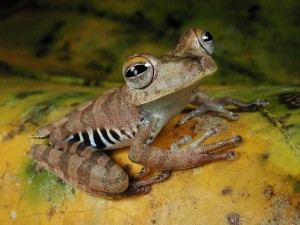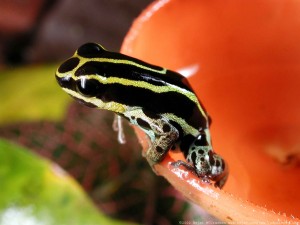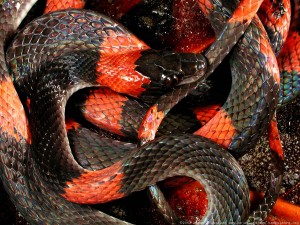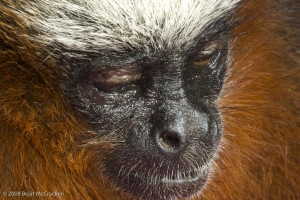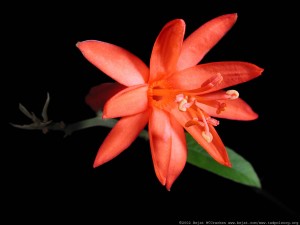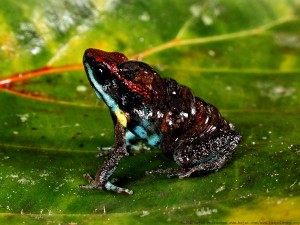
Each day as we moved further from the core of the Jama-Coaque Reserve, installing our canopy acoustic and imaging stations to monitor wildlife use and movement along a conservation corridor, the sounds of chainsaws became more frequent and closer to our ears. As the days wore on the toll of transporting 150 pounds of equipment for up to 13 hours a day while bushwhacking our way along steep ridge tops at the equator and climbing trees up to 38 meters (124 feet) to install our equipment was drowning out our ability to notice much of anything. On this day we had reached the outer boundary of the Reserve and were getting close to our next randomly generated point on the map to find a tree and install our canopy monitoring station. About 30-40 meters away from a continuous buzzing chainsaw I called for a pack’s off break to have some water and another peanut butter and jelly sandwich. Strangely, I didn’t much contemplate the impending encounter even though I had never faced illegal loggers in the forest. I knew we could go around them, but I wasn’t really worried about surprising them with our presence. Maybe I should have been, but I was tired of hearing chainsaws and, well, just tired. We listened to the crack of another tree trunk as the chainsaw idled down, but it didn’t hit the ground. Like a wounded soldier being carried by his brave brothers it was being held up by the surrounding canopy trees and lianas, the chainsaw redirected its aim at them.
I pressed the start video recording button on my cell phone and hung it from my backpack’s chest strap. I was determined to get evidence to do something about their activities without them being clued into my intentions. Machete in hand, I moved towards the chainsaw yelling “hola, buenas tardes” between rev’s of the chainsaw. It shut down immediately and I walked into the clearing right next to the suspend cut tree trunk at head level. I suddenly realized I was not in the safest position and quickly moved past it towards the older man who had passed the chainsaw off to who I believe was his son. Both were clearly shocked to see gringos in the middle of nowhere. The son stood frozen for a few seconds before he took off with the chainsaw – going to hide the murder weapon. I approached and greeted the older man with a handshake. I wanted to make sure I got good video footage. I had decided to play the role of the dumb gringo who had lost his way along the virtually non-existent trail following the undulating ridge line. The man told me we were on his finca (farm) and the trail was further up the ridge line. I knew we weren’t on his property; I had looked at the property boundary maps downloaded to my GPS app before the decided encounter. We were near the boundary of the last Reserve properties owned by the Third Millennium Alliance conservation organization or a conservation easement they had with a local landowner. Regardless, this location was within the private Jama-Coaque Reserve and this man and his son were committing a crime. As the man walked away, I turned and told my companions to make their way quickly past the dangling tree. I made sure I had decent video of the tree stump and cutting area, and we all headed up to the trail. I said thank you and goodbye to the man, then our team headed down the trail a short way before stopping to discuss where we should venture off-trail to locate our next trail. The man and his son showed up immediately, no chainsaw in sight, and made their way past us after a cordial “hasta luego” and a penetrating glare from both in my direction. In a way it was all a bit anticlimactic. I certainly felt a small sense of success having surprised them and obtaining evidence of their crime, but it would be short lived that day.
After the intensity of locating and installing another of our canopy monitoring stations, we realized we would once again be hiking back to the station in the dark. There were still several sections of the “trail” that we continued to get lost on, especially at night. We also wanted to find a shorter way back to the main trail from the tree we had selected for today’s work. With the sun setting quickly I began the daunting task to machete towards the main trail in a straight line. It wasn’t long and we popped out onto a freshly cleared and very wide trail. We soon began to see why as we came upon tree stumps, piles of trimmed branches and bamboo harvested and being processed. Even large trees where the surrounding dense bamboo stands that had protected them had been cleared away for their eventual fall to the ground. It was a devastating sight, but we still had a 3+ hour hike back to the station.
I wanted to share this story because this is what the front lines of conservation looks like in western Ecuador and so many other areas of the planet. I remember telling my team that day after the encounter that this is why we are doing the work we do. Our research will directly inform applied conservation initiatives as part of a greater community conservation project being led by Third Millennium Alliance. Our goal is to educate and incorporate people like these illegal loggers in our forest friendly cacao program. A program that provides a sustainable alternative to deforestation and works to reforest already degraded habitat in and adjacent to the Three Forests Conservation Corridor and the Jama-Coaque Reserve. This incident and the other illegal logging activities are occurring on the outer fringes of the now 1600 acres of reserve that are infrequently patrolled because of their long distance away from the core of the reserve and our limited personnel. Funding to purchase land for conservation and even research projects seems to be much easier to obtain than money to actually pay people to do on the ground conservation work. I’m still baffled by this reality, especially since it only cost about $7000 a year for one full-time employee in Ecuador to work as a reserve ranger and parabiologist. If we could employ one or two rangers from the local or nearby communities, this would ensure the end of illegal activities on the growing outer borders of the reserve. All it takes is a physical human presence in these areas and outsiders will stay away, especially if it is someone they know or recognizes them.
Hopefully, I’ve stimulated your conservation conscience a bit. Working at the front lines of conservation in a remote area of a developing country is nothing like conservation in the US; I’ve been doing both for a while now but nothing this intense. If you or anyone you know can help us hire 1-2 reserve rangers we need that help now. Think about it – if we could get just 70 people a year to donate $100 we could hire a full-time ranger (do the math and that’s 0.27 cents a day), double that and we can hire two! Please, if you or anyone you know want to donate please visit http://tmalliance.org/donate/ and donate today. I sincerely thank you.
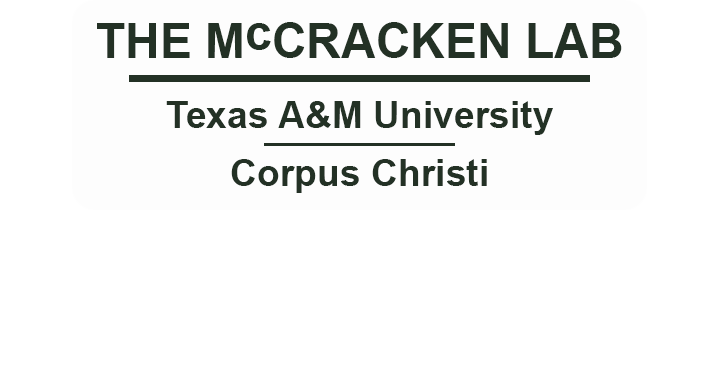











 not the imagery to fly by and setup a mission that maintained 150m above each waypoint. It was either going to fly the mission and come home or slam into the treetops on the mountainside opposite us. Twelve minutes later the hexacopter parked at the home position and I brought it down for a landing. Landing in about a 1m square area on the side of a mountain proved challenging to say the least. We eventually devised a plan that would require at least a few 2x3m takeoff and landing areas on the mountaintops for running the required missions to map all of the reserve. Wouter Hantson, TMA GIS expert, is also going to create a better basemap to load into Mission Planner for the future mapping efforts. This will greatly increase our confidence in mission development. Dodging rains at the start of the rainy season and dealing with some power issues to keep everything charged we managed to get several more flights in and work out the rest of the strategy for mapping the entire reserve.
not the imagery to fly by and setup a mission that maintained 150m above each waypoint. It was either going to fly the mission and come home or slam into the treetops on the mountainside opposite us. Twelve minutes later the hexacopter parked at the home position and I brought it down for a landing. Landing in about a 1m square area on the side of a mountain proved challenging to say the least. We eventually devised a plan that would require at least a few 2x3m takeoff and landing areas on the mountaintops for running the required missions to map all of the reserve. Wouter Hantson, TMA GIS expert, is also going to create a better basemap to load into Mission Planner for the future mapping efforts. This will greatly increase our confidence in mission development. Dodging rains at the start of the rainy season and dealing with some power issues to keep everything charged we managed to get several more flights in and work out the rest of the strategy for mapping the entire reserve.







